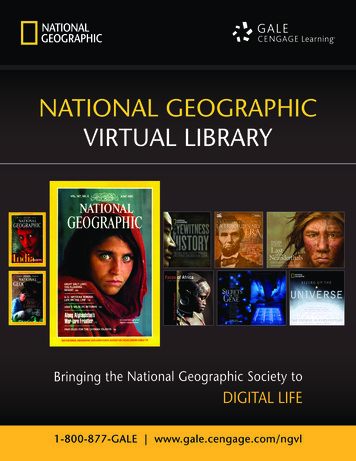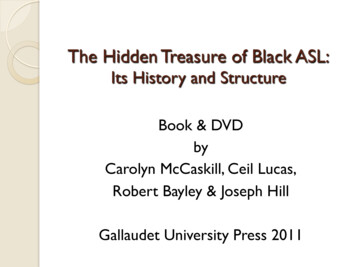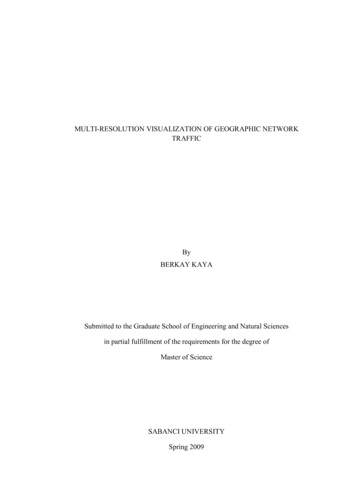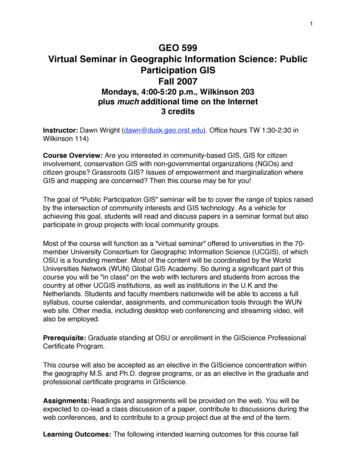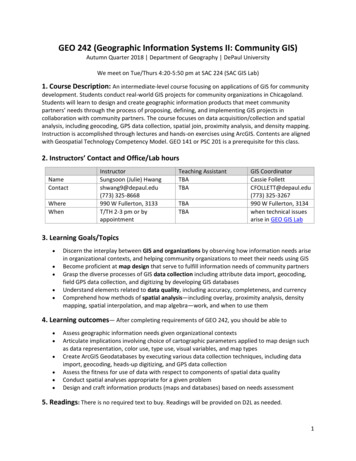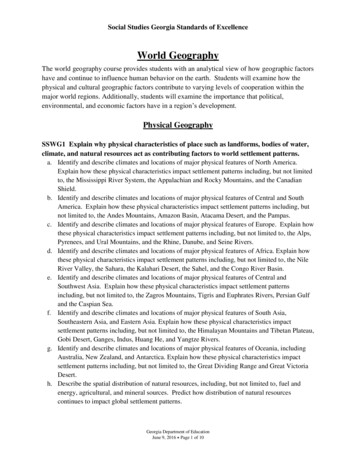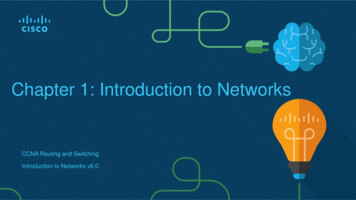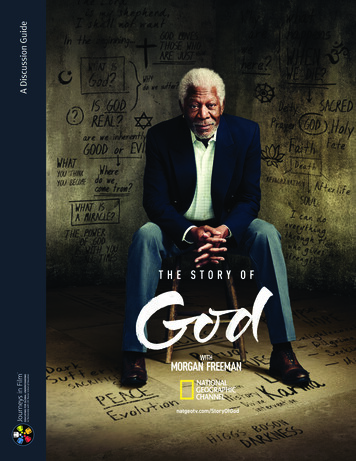
Transcription
A Discussion Guide
For community screenings, panels, and workshops,and college courses and seminarsIn Partnership with USC Rossier School of Education 2016 NGC Network US, LLC and NGC Network International, LLC. All rights reserved.Journeys in Film: The Story of God
Table of ContentsIntroduction to The Story of God4A Letter From Executive ProducersMorgan Freeman and Lori McCreary5Episode 1: Beyond Death6Episode 2: Apocalypse9Episode 3: Who Is God?12Episode 4: Creation15Episode 5: Why Does Evil Exist?18Episode 6: The Power of Miracles21Journeys in Film: The Story of God
Introduction toThe Story of God, With Morgan FreemanMorgan Freeman, the actor who played God in the 2003 filmHumans have speculated about these questions for eons. NowBruce Almighty, has undertaken a six-part series on worldMorgan Freeman takes the viewer with him as he attemptsreligions called The Story of God. The 78-year-old actorto learn more about how humans have tried to answer thesetraveled almost 100,000 miles to trace the origins of the greatquestions across continents and millennia. This discussionworld religions. He visited sacred sites—a Maya temple inguide has been prepared to help you understand more aboutGuatemala, the ghats of Varanasi in India, Vatican City inwhat you see on the screen and to follow up with additionalRome, the pyramids of Egypt, and more. He interviewedreading on the topics that stir your interest.monks and monsignors, imams and rabbis, scientists andscholars. The result is a survey of themes that these religionsshare. They all ask the same great questions, but may answerthose great questions in a variety of ways. How did we get here? Who or what created the universe?What do the creation stories of different religions havein common? What does the scientific theory of the BigBang tell us? Is there a God? How has the idea of one or more supremebeings evolved over time? Is there any evidence in ourbrains that we are predisposed to believe in God? What is evil? Where does it come from? How is the needto control evil related to the rise of civilizations? Can miracles be real? How can we understand theexistence of “impossible” happenings? How will the world end? Will there be a fiery apocalypse?What will bring about the end of the world as we know it? What happens after we die? How has belief in the afterlifeevolved?4Journeys in Film: The Story of God
A Letter From Morgan Freeman and Lori McCrearyDear All,Who is God? Where did we comefrom? Why does evil happen?Are miracles real? What happenswhen we die? These questionscan be puzzling, terrifying,even inspirational. We’ve askedourselves these questions manytimes, and most likely, you have,too. The answers are often asdifferent as you and I, and varydepending on where you live,how you were raised, and whatyou believe.That’s why we set out on thisglobal journey—to exploredifferent cultures and religions,on the ultimate quest to uncoverthe meaning of life, the questionof God, and everything in between. We are proud to bringyou this story and share our findings on how faith has shapedour lives and influenced the evolution of our society.Religion has changed throughout the course of civilization,dividing as much as inspiring. But even in our currentgeopolitical landscape, our experiences in nearly 20 cities—in seven different countries—shed a brilliant light on theremarkable and unmistakable similarities among differentfaiths, even those that historically have been at odds or seemto stand in stark contrast to one another.We went to some of mankind’s greatest religious sites. Wetraveled with archaeologists, immersed ourselves in religiousexperiences and rituals all around the world, and evenbecame test subjects in scientific labs, where the frontiers ofneuroscience are intersecting with the traditional domain ofreligion. We’ve sung the call to prayer at a mosque in Cairo,taken meditation lessons from the Buddhist leader of theoldest line of reincarnating lamas, discussed Galileo with thehead of the Papal Academy of Sciences, and explored the firstinstructions for the afterlife rendered in hieroglyphs insidethe pyramids of Egypt.In the end, what surprised us most was finding how personalthose answers were for each and every one of us. There is nowrong answer when it comes to understanding God or whatyou believe. We hope The Story of God and this discussionguide will spark new interfaith conversations and begin awider dialogue about the ideas and values that we all share—rather than focusing on those we do not.It is our pleasure and great joy to bring you this special series,and our hope that you’ll find our journey as enlightening andinspirational as we did.Blessings to you,Morgan Freeman and Lori McCrearyExecutive ProducersThroughout this personal journey, we found many answers.In some places, we found only more questions. But throughit all, the one constant we discovered—the one irrefutablefact—is that we’re all looking to be part of something biggerthan ourselves.Journeys in Film: The Story of God5
Episode 1Beyond DeathWe have the power to live life in a way that others remember us.And become eternal, like the stars.— Morgan Freeman1. The episode opens as Morgan Freeman is walking over2. David Bennett believes that he drowned when he wasa wooden bridge in Greenwood, Mississippi. He reflectsa young man, but his body was recovered and he wason the fact that he first faced someone’s death as a boyresuscitated. How does he describe the experience of death?there. As an infant, he had been left in the care of hisHow is his experience similar to that of others who havegrandmother, who died when he was six years old. Hishad near-death experiences? How could such an occurrenceolder brother also died when Freeman was young. Whatbe explained? How do you think such an experience mightwas your own first experience with death? How did it affectchange a person? Has your personal understanding of nearyou? Did you have family or caretakers to help you deal withdeath experience changed after seeing this episode?it or did you handle it on your own?3. Egyptologist Salima Ikram leadsMorgan Freeman into a pyramidin the funerary complex of Djoserin Egypt, which serves as the tombof a pharaoh who lived almost4,400 years ago. After walking aremarkably well-preserved pathwayand bending almost double to comethrough another passage, he findshimself in a room covered withinscriptions for another pharaoh,Unas. What do the inscriptions say?What did they indicate about how theEgyptians viewed the afterlife? Whywas the king’s afterlife important tothe Egyptian people?6Journeys in Film: The Story of God
4. Although the pyramid at Saqqara is an ancient and detailedtestimonial of belief in the afterlife, there is evidence thathumans may have believed in some sort of life after deatheven before the Egyptians developed their elaborate theoryof the afterlife. What does this evidence consist of?5. The Mexican Day of the Dead (Día de los Muertos),celebrated primarily in southern Mexico, had its roots inindigenous celebrations held in early summer. Since theSpanish conquest, the festival takes place on November1 and 2, coinciding with the Catholic Church holy daysof All Saints’ Day and All Souls’ Day. How do Mexicanfamilies celebrate the Day of the Dead? Why is it considereda happy rather than sad time? What does it say aboutpractitioners’ belief in the afterlife?different from the Jewish vision of what happens after death?Do you think this is the reason that Christianity spread sorapidly?8. Morgan Freeman states, “Christians believe you onlyhave one chance to live a good life and make it to heaven.But Hindus believe you have more than one chance.With reincarnation, death is just a step on the way tothe next life.” Both Hindus and Buddhists believe that6. The Aztec Empire shocked the Spanish conquistadorslife is cyclical (samsara). The way you live in this life willwith its use of ritual human sacrifice. The Maya also haddetermine how you will be reborn in the next life (karma).human sacrifice, although not to the extent that the AztecsWhat is reincarnation? What is the goal of reincarnation?practiced it. Why did these societies sacrifice humans? WhatWhat is meant by the term “moksha” (similar to the ideadid they hope to accomplish by this practice?of “nirvana” in Buddhism)? Why is cremation at the7. In the Church of the Holy Sepulchre in Jerusalem, on theMarnikanika ghat (cremation place) in Varanasi consideredso important?site where Christians believe that Jesus died, was buried,and rose again, Morgan Freeman learns about ancient9. Dr. Sam Parnia has been studying the near-deathJewish burial customs. Describe the nature of the Jewishexperiences of almost 2,000 people. What has he learnedcemetery shown in the film. Does it in your opinion lendabout what happens when we die? Does this support or refutesupport to the story of Jesus in the Gospels, as archaeologistDavid Bennett’s story of drowning from the beginning of thisJodi Magness says? How was Christian belief in the afterlifeepisode?Journeys in Film: The Story of God7
Beyond Death: For further reading and /A reporter’s analysis of scientific research on ?v wwWuF6KL4d8National Geographic video exploring Egyptian beliefs aboutthe afterlife: “Egypt Underworld — Pathways to oric-religionA quick survey of prehistoric religious belief based onarchaeological evidencehttp://latino.si.edu/dayofthedead/The Smithsonian page on the Day of the Dead, completewith fact sheet and teacher lesson plans10. Martine Rothblatt says that his robot Bina 48 is anexperiment “to encourage technology to allow peoplewho love life, including loving other people in life, tocontinue that love indefinitely into the future.” What isyour reaction to this segment? Do you think that roboticscan eventually “cheat death” as Rothblatt suggests?11. The Temple of Millions of Years was built by Rameses IIIto give him eternal life. According to Egyptologist eatures/2173mexico-city-aztec-buried-worldAn article about recent archaeological discoveries about theAztec reasons for human tsection/item.php?itemid 1667A detailed discussion of Hinduism’s beliefs about dying,reincarnation, karma, and the proper rites for the deadIkram, when Rameses’ name is pronounced, his ka a48-mind-clone/a burst of energy and his life is extended. How important isA news report about the creator of the Bina 48 mind-clonethe immortality he achieved because later generations bu.htmlhis name? How does Morgan Freeman interpret this conceptin his own life?Background information about Rameses III and hisMansion of a Million Years12. At the end of the series The Story of God, Morgan Freemanmakes a personal statement:It is my fervent hope that people will open their hearts andminds and see that our beliefs don’t have to divide us: Theyhave the power to unite us. They allow us, together, toachieve remarkable things.Do you think that he is right, that knowing more about thebelief of others can make our world more peaceful?8Journeys in Film: The Story of God
Episode 2ApocalypseAs I’ve traveled the world, my understanding of the apocalypsehas evolved. I had always thought of it as an all-destroying doomsday.But I’ve discovered that some people yearn for the apocalypse:They want to be free of injustice. They want to escape suffering.They want to see the ultimate truth.— Morgan Freeman1. Hurricane Katrina struck New Orleans in August 2005.There are numerous other examples. What might explainThe Category 3 storm with 100–140 mph winds did severewhy so many cultures have apocalyptic stories of great floods?damage, but the destruction was vastly increased whenIs the archetype of the flood merely a metaphor? If so, whatlevees failed and much of the city was flooded. Over adoes it represent?thousand people died, many more lost their homes, andproperty damage was estimated to be over 100 billion.Why does Morgan Freeman begin his story of the apocalypsein New Orleans? Is this an effective opening? Have you everfound yourself in a dangerous situation caused by naturalforces? If so, how did you feel? How did you react?2. The archetype of a catastrophic flood destroying3. When Morgan Freeman goes to Jerusalem, he visits theWailing Wall and the parts of the Temple of Jerusalemthat remain underground; he learns about the desireof many Jews to rebuild the Temple. What is the Jewishunderstanding of a Messiah? How is this vision of a Messiahdifferent from that held by the other two Abrahamicreligions, Christianity and Islam?humankind appears in many forms in history andmythology: Noah’s floodand the flood in the storyof Gilgamesh from theNear East; the Greek storyof Deucalion’s flood; theIndian story of the firstman, Manu; and the Azteccouple Tata and Nena, whosurvive a great flood withthe help of the god of rains.Journeys in Film: The Story of God9
4. When Morgan Freeman goes to Qumran, outside of thesome people have been superstitious about this numbercity of Jerusalem, he learns about a religious sect, theand refuse to use it; the superstition actually has a name,Essenes, who lived in the desert there until they werehexakosioihexekontahexaphobia. What does the numberdestroyed by the Romans in 70 CE. Who were the Essenes?666 stand for in the Book of Revelations? Why does HainesWhy did they withdraw from the main body of Judaism?think that the number 666, popularly attributed to the Anti-What do their apocalyptic writings suggest about the end ofChrist, is actually a coded word for the Emperor Nero?the world? Why are the Dead Sea Scrolls so important?6. When Morgan Freeman interviews a former jihadist in5. At the Biblioteca Casanatense, Morgan Freeman views someEngland, he learns of a connection between belief in anpapyrus fragments of the Book of Revelations, which wasapocalypse and the terrorist movements of Al-Qaeda andwritten in Greek. Kimberly Haines, the scholar he speaksISIS in the Middle East. What is the explanation that Maajidwith there, thinks that Revelations is political. She bases herNawaz gives for his eventual rejection of jihadist thinking?opinion on the Greek tradition of isopsephy, the tradition ofWhat does he suggest about the connection between anapplying numbers to the letters of a name. In modern times,apocalypse and the current world terrorist crisis?10Journeys in Film: The Story of God
7. In Tikal, the ancient Maya capital in Guatemala, MorganFreeman finds out more about the reputed Maya prophecyof the end of the world, which had many people nervousabout December 21, 2012. What were the baktun? How didthey fit into the Maya understanding of time? How did thismisunderstanding of the “prophecy” occur?8. The Gwalyang Karmapa is the 17th Karmapa, a term thatmeans “the embodiment of Buddhist activity.” Born inTibet, he was recognized by monks as a reincarnation ofthe 16th Karmapa and was given his title at age seven; at age14, he left Tibet secretly and went to India to continue hisstudies. In the video, he talks with Morgan Freeman aboutthe concept of enlightenment. What advice does he give onhow to meditate? What is the Karmapa’s understanding ofthe concept of apocalypse?Apocalypse: For further reading and lems-holiest-place.htmlAn article concerning the debates about the location of theTemple in Jerusalemhttp://www.deadseascrolls.org.il/An introduction to the Dead Sea Scrolls from the IsraelAntiquities muslim-views-ofthe-apocalypse n 2635839.htmlA brief article on the Muslim concept of the apocalypse. Thescholar mentioned in the article, Dr. Abdulaziz Sachedina,is the author of Islamic Messianism: The Idea of the Mahdi inTwelver 1/features/386-mayalong-count-calendarDiscussion of the Maya calendar and its meaningwww.kagyuoffice.org9. How has Morgan Freeman’s idea of the apocalypse changedover the course of his journey? Why does he say some peopleyearn for the apocalypse?10. When the video returns to New Orleans, Morgan Freemanis again speaking with Charles and Angela Marsalis. Howdid the “apocalypse” of Hurricane Katrina change theirThe website of the 17th Gyalwang Karmapa, with information about his biography, his activities, and Buddhism -anniversary-neworleans/A 10-year retrospective on Hurricane Katrina in NewOrleans, with links to stories in the Time magazine “vault.”lives? What did it teach? Freeman says that the attitude ofthe couple is very “Buddhist.” What does he mean by that?Do you agree?11. At the conclusion of the video, Morgan Freeman sumsup: “Apocalypse is a Greek word meaning ‘lifting theveil.’ It’s not about war, it’s about enlightenment. It’s notabout death; it’s a state of mind and heart that helps us seethe truth. Not some far off day of judgment, it’s here, it’snow.” Explain in your own words what you think he meansby this. Do you agree? Has your personal interpretation ofthe idea of apocalypse changed after seeing this episode?Journeys in Film: The Story of God11
Episode 3Who Is God?The answer to who God is lies in our imaginations and our ideals.Whether we pursue these divine ideals alone or in a communityof thousands does not matter. Only that we strive for the spiritualconnections that make our lives richer.— Morgan Freeman1. This episode begins at a blues club in the Mississippias 30,000 people now attend weekly, and the church’sDelta, where Morgan Freeman recalls great blues playerstelevision broadcast in a hundred countries reachessuch as Muddy Waters and B.B. King. He mentions thatan estimated 7 million. What vision of God does Pastorthey have passed on but their spirit is still living. Why doOsteen seem to have? What words does he use to describe theyou think Morgan Freeman begins an episode on the conceptrelationship between God and humans? Why do you thinkof God with this scene?this church appeals to so many people in an age when church2. Lakewood Church, a megachurch in Houston that ishoused in a former basketball arena, was founded in 1959by Pastor Joel Osteen’s father, John. When the father died40 years later, his son Joel took over as pastor. As manyattendance nationally is declining? Some critics have calledthis an example of the “prosperity gospel,” the belief thatGod blesses favored people with material wealth. Do you seeany evidence of that in this scene?3. Traveling to India, Morgan Freeman learns that Hindusbelieve in a multiplicity of gods—millions, in fact; thereis a shrine at every corner. Hindu gods may take the formof natural forces, animals,and supernatural beings.How do Hindus decide whichgods to honor? How do theyhonor them? What is thepurpose of the puja ceremonythat Freeman witnesses?What does Freeman meanwhen he says Hindu belief islike a “spiritual fingerprint,”unique to each person?12Journeys in Film: The Story of God
and the new ring built overthem was aligned withthe shadows of the wintersolstice. Paul Garwoodand Vince Gaffney,professors of prehistoryand archaeology at theUniversity of Birmingham,theorize that the newmonument shows anemerging belief in onegod, the sun. Why would4. At the bowl-shaped basin called Tnorala in Australia,worship of the sun have helped early humans survive? WhatMorgan Freeman talks with a descendant of the Aboriginalwere these monuments used for? It has been estimated thatpeople who were caretakers of the sacred place. He hearsbuilding the newer henge took a million man-hours tothe sacred story of parents whose baby fell to earth frommove 100,000 tons of chalk. Why would people go to suchthe heaven, forming the crater of Tnorala. How doesextraordinary lengths to build such a structure?science provide insight into the origin of this story? Whatis the understanding of God as envisioned by the Arrerntepeople of Australia?7. Sun worship also ruled at the time of the PharaohAkhenaten in Egypt (approximately 1353–1336 BCE). Hebegan his reign as Amenhotep IV, but changed his name to5. In trying to understand if God is a product of ourreflect his dedication toimagination or if God hardwired us to feel a connectionthe sun god, Aten. Howwith the divine, Morgan Freeman visits a neuroscientistdid Akhenaten attemptwho has done extensive work on changes in the brainto change religious beliefduring meditation; the scientist calls his search for answersin Egypt? What were his“neurotheology.” The effect is measured by injectingmotives? How effectiveradioactive dye into the subject’s bloodstream. He thenwas his attempt to imposeuses a SPECT (single-photon emission computerizedmonotheism on the peopletomography) scanner to measure changes in the subject’sof his country? Did he havebrain activity. What are the physical effects of meditation onany long-lasting effect?the brain? Is the effect on an atheist’s brain similar to that onthe brain of a believer?8. The Old City section of Jerusalem contains sacred sitesfor three major religions: The Dome of the Rock and6. A C-shaped ring of large stones buried in a field calledAl-Aqsa Mosque; the Mount of Olives and the valleyDurrington Walls near Stonehenge, in Great Britain, isof Gethsemane; and the Western Wall of the Temple.built over a deeper ring of stones that faced a line of hillsJudaism, Christianity, and Islam are called Abrahamicto the east. Those deeper stones were toppled and buried,religions because they began with Abraham, whomJourneys in Film: The Story of God13
Who Is God? For further reading and xHome page of Lakewood Church in son contents.htmlThe Asia Society’s introduction to Hindu belief for 11/03/impact-cratersin-aboriginal-dreamings 28.htmlA blog post about the Aboriginal story of Tnorala and theArrernte oral -your-brain/the Jewish philosopher Yoram Hazony calls “the firstmonotheist.” Why do you think the monotheism of theearly Jews, Christians, and Muslims was successful whenAkhenaten’s monotheism died out with his reign? Whatkinds of controversy now surround the Temple Mount?9. While visiting the Al-Hussein Mosque in Cairo, MorganFreeman learns about the Islamic tradition of the callto prayer, issued by a muezzin, a man chosen for hisexceptional voice. The imam says that the beauty of thevoice would be the manifestation of God. What othermanifestations of beauty help Muslims encounter the divine?Additional information about the impact of meditation onbrain x.htmA list of stone circles in Great Britain, including Stonehengeand Durrington Walls, with additional information about ters/10AKHEN.htmA Web page by Prof. Mark Damen of Utah State Universityabout Akhenaten’s attempt to impose at-is-beneath-thetemple-mount-920764/?no-istAn archaeological dig illuminates the ancient causes of someof the controversy surrounding the Temple Mount.Why are the walls of the mosque covered with c-world/unit-twoWhy are there no statues such as you might find in aThe Metropolitan Museum’s unit on Arabic calligraphyChristian or Hindu shrine?10. What is your reaction to the following statement by MorganFreeman? “ [T]here is a bit of the divine in all of us.There’s God in you, and God in me. The God in me is whoI really am at my core. The God in me is the best version ofme. The God in me is who I strive to be, who I was meant tobe.” Do you agree or disagree? Why?14Journeys in Film: The Story of God
Episode 4CreationSo I’m setting off on a journey to discover why we believe what webelieve and what our faiths have in common.— Morgan FreemanWere you surprised to find that these accounts were fromthree different ancient texts—the Rig Veda, Genesis, andthe Popul Vuh, respectively? What do these passages have incommon? How do they differ?2. In comparison with the preacher in the Greenwood church,Morgan Freeman does not find the story of Creation tobe easy; to him, Genesis is quite a puzzle. He goes to theVatican, where he sees the traditional Christian six days ofCreation illustrated on Michelangelo’s Sistine Chapel ceilingand then interviews Monsignor (now Archbishop) MarceloSánchez Sorondo, chancellor of thePontifical Academy of Sciences. Indiscussing Galileo, the monsignortells Freeman that the story aboutGalileo being at odds with theChurch may be apocryphal. In fact,Galileo was forced to recant his proofs of the Copernican1. In the opening of this episode, Morgan Freeman recitesthree brief passages about the creation of the world:“There was neither nonexistence nor existence norealm of air, no sky beyond it.”“And God said, ‘Let there be light.’ And there was light.”heliocentric system in 1633 and his “Dialogue Concerningthe Two Chief World Systems” was placed on the Church’sIndex of Forbidden Books. In 1992, the Pontifical Academyof Sciences announced to the world that Galileo had beenright after all.Why do you think Monsignor Sorondo wanted to minimize“In order to create the Earth, they said, ‘Earth,’ andthe controversy about Galileo? What do you think theimmediately it was created.”monsignor meant when he distinguished between theJourneys in Film: The Story of God15
literal Biblical account of creation (theological) and the BigBang theory (scientific)? Can a person of faith believe bothaccounts simultaneously? How can they be reconciled?3. In considering the relationship between Islam and science,Morgan Freeman says, “Scholars in Cairo kept science alivewhile Europe lumbered through the Dark Ages.” Manyadvances in astronomy,mathematics, chemistry,navigation, and medicinewere in fact made duringthe Golden Age of sciencein the Islamic world, whichstretched from Spain toChina. Modern students arefamiliar with algebra, thename of which comes fromArabic. “Arabic” numerals,brought back from NorthAfrica by Fibonacci, make math much simpler than it wasin Roman times. What was the Muslim understanding ofthe beginnings of the universe? How close is it to the tenets ofmodern science?4. Morgan Freeman continues on his journey to the Indiancity of Varanasi on the Ganges River. What does he learnabout the Hindu story of the role of the Ganges in creatingthe world? Why is the river so important to Hindu culture?Why is water pollution in the Ganges such a threat?5. Morgan Freeman is interested in the earliest manifestationsof religion and visits several archaeological sites in aquest for an answer to this question: Did living togethertrigger the birth of religion or did religion already exist?6. Moving to the Americas, Morgan Freeman visits ElMirador in the Guatemalan jungles, the center of theMaya kingdom, perhaps the biggest metropolis in theworld 2000 years ago. There he sees stone carvings thattell the story of Creation, the oldest version of the PopulVuh in the world. Who were the hero twins and what wastheir role in the Maya creation story? What is the connectionbetween corn and the Maya people? How do the modern-daydescendants of the Maya continue to honor this tradition?7. The last stop on Morgan Freeman’s journey in this episodeis a Navajo home, called a hogan, where a Kinaaldá istaking place. He spends time interviewing Mason, theyoung woman undergoing the Kinaaldá, her sister, andher other female relatives. What must a Navajo girl do totake her place as a woman? How are these rituals associatedwith creation? With the story of Changing Woman, whocreated the first human beings from her own skin?8. Morgan Freeman says that these oldest stories connect usall, that they are the glue of civilization. Do you agree ordisagree with him? Why?What does he learn about early human religious beliefs atthe excavation site of Çatalhöyük (chat-uhl-HER-yuk)and Gobekli Tepe? What evidence have archaeologists andanthropologists uncovered to suggest belief systems of thepeople who lived there?16Journeys in Film: The Story of God
Creation: For further reading and n.htmlThe home page of the Pontifical Academy of es.htmlAn account of the Vatican rehabilitation of ibraryA quirky, Harry-Potteresque film about Islamic sciencehttp://www.muslimheritage.com/scienceA website on the Golden Age of Muslim Science from theFoundation for Science, Technology and CivilisationJourneys in Film: The Story of /A photo story of the journey of National Geographic photographer Pete McBride as he followed the Ganges Riverfrom the Himalaya to the seahttp://www.catalhoyuk.com/The official site of the Çatalhöyük excavation projectwww.mythweb.com/teachers/why/other/hero twins.htmlAn entertaining version of the story of the Maya herotwinshttp://xroads.virginia.edu/ ma97/dinetah/change2.htmlA detailed explanation of Changing Woman and her connection to creation and the Kinaaldá17
Episo
The Story of God, With Morgan Freeman Morgan Freeman, the actor who played God in the 2003 film Bruce Almighty, has undertaken a six-part series on world religions called The Story of God. The 78-year-old actor traveled almost 100,000 miles to trace the origins of the great

